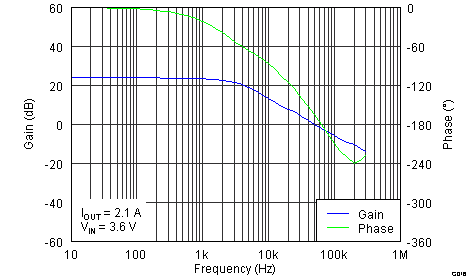ZHCSB48B May 2013 – January 2019 TPS55330
PRODUCTION DATA.
- 1 特性
- 2 应用
- 3 说明
- 4 修订历史记录
- 5 Pin Configuration and Functions
- 6 Specifications
- 7 Detailed Description
-
8 Application and Implementation
- 8.1 Application Information
- 8.2
Typical Application
- 8.2.1 Design Requirements
- 8.2.2
Detailed Design Procedure
- 8.2.2.1 Custom Design With WEBENCH® Tools
- 8.2.2.2 Selecting the Switching Frequency (R4)
- 8.2.2.3 Determining the Duty Cycle
- 8.2.2.4 Selecting the Inductor (L1)
- 8.2.2.5 Computing the Maximum Output Current
- 8.2.2.6 Selecting the Output Capacitor (C8-C10)
- 8.2.2.7 Selecting the Input Capacitors (C2, C7)
- 8.2.2.8 Setting Output Voltage (R1, R2)
- 8.2.2.9 Setting the Soft-start Time (C7)
- 8.2.2.10 Selecting the Schottky Diode (D1)
- 8.2.2.11 Compensating the Control Loop (R3, C4, C5)
- 8.2.3 Application Curves
- 9 Power Supply Recommendations
- 10Layout
- 11器件和文档支持
- 12机械、封装和可订购信息
8.2.2.11 Compensating the Control Loop (R3, C4, C5)
The TPS55330 requires external compensation which allows the loop response to be optimized for each application. The COMP pin is the output of the internal error amplifier. An external resistor R3 and ceramic capacitor C4 are connected to the COMP pin to provide a pole and a zero, shown in the application circuit. This pole and zero, along with the inherent pole and zero of a boost converter, determine the closed loop frequency response. This is important for converter stability and transient response. Loop compensation should be designed for the minimum operating voltage.
The following equations summarize the loop equations for the TPS55330 configured as a CCM boost converter. They include the power stage output pole (ƒOUT) and the right-half-plane zero (ƒRHPZ) of a boost converter calculated with Equation 27 and Equation 28 respectively. When calculating ƒOUT it is important to include the derating of ceramic output capacitors. In the example with an estimated 61 µF capacitance, these frequencies are calculated to 521 kHz and 2.2 kHz respectively. The DC gain (A) of the power stage is calculated with Equation 27 and is 39.9 dB in this design. The compensation pole (ƒP) and zero (ƒZ) generated by R3, C4 and internal transconductance amplifier are calculated with Equation 30 and Equation 31, respectively.
Most CCM boost converters will have a stable control loop if fZ is set slightly above ƒP through proper sizing of R3 and C4. A good starting point is C4 = 0.1 µF and R3 = 2kΩ. Increasing R3 or reducing C4 increases the closed loop bandwidth, and therefore improves the transient response. Adjusting R3 and C4 in opposite direction increases the phase and gain margin of the loop, which improves loop stability. It is generally recommended to limit the bandwidth of the loop to the lower of either 1/5 of the switching frequency ƒSW or 1/3 the RHPZ frequency, ƒRHPZ shown in Equation 28. The spreadsheet tool located in the TPS55330 product folder at SLVC430 can also be used to aid in compensation design.







Where
- COUT is the equivalent output capacitor (COUT=C8+C9+C10)
- ROUT is the equivalent load resistance (VOUT/IOUT)
- Gea is the error amplifier transconductance located in the Electrical Characteristics table
- RSENSE (15 mΩ, typical) is the sense resistor in the current control loop
- ƒco1 and ƒco2 are possible bandwidth.
An additional capacitor from the COMP pin to GND (C5) can be used to place a high frequency pole in the control loop. This is not always necessary with ceramic output capacitors. If a nonceramic output capacitor is used, there is an additional zero (fZESR) in the control loop which can be calculated with Equation 35. The value of C5 and the pole created by C5 can be calculated with Equation 36 and Equation 34 respectively. Finally if more phase margin is needed, an additional zero (fZFF) can be added by placing a capacitor (CFF) in parallel with the top feedback resistor R1. TI recommendeds placing the zero at the target cross-over frequency or higher. The feed forward capacitor also adds a pole at a higher frequency. The recommended value of CFF can be calculated with Equation 37.




where RESR is the ESR of the output capacitor.
If a network measurement tool is available, the most accurate compensation design can be achieved following this procedure. The power stage frequency response is first measured using a network analyzer at the 3.6 V input and maximum 2.1 A load. This measurement is shown in Figure 17. In this design only one pole and one zero are used, so the maximum phase increase from the compensation will be 180 degrees. For a 60 degree phase margin, the power stage phase must be –120 degrees at its lowest point. Based on the target
10 kHz bandwidth, the measured power stage gain, KPS(fBW), is 13.3 dB and the phase is –87 degrees.
 Figure 17. Power Stage Gain and Phase of the Boost Converter
Figure 17. Power Stage Gain and Phase of the Boost Converter R3 is then chosen to set the compensation gain to be the reciprocal of the power stage gain at the target bandwidth using Equation 38. C4 is then chosen to place a zero at 1/10 the target bandwidth with Equation 39. In this case R3 is calculated to be 1.87 kΩ, the nearest standard value 1.87 kΩ is used. C4 is calculated at
0.085 µF and the nearest standard value 0.100 µF is used. Although not necessary because this design uses all ceramic capacitors, a 270-pF capacitor is selected for C5 to add a high-frequency pole at a frequency 100 times the target bandwidth.

